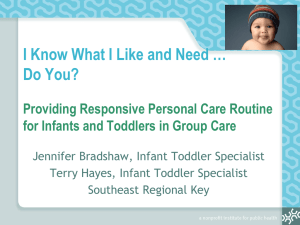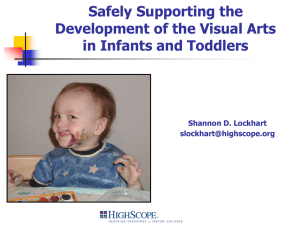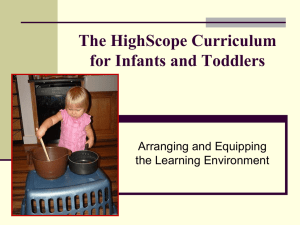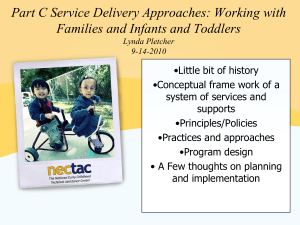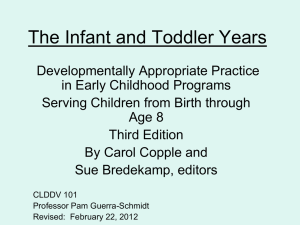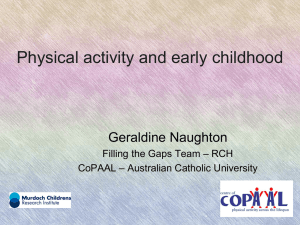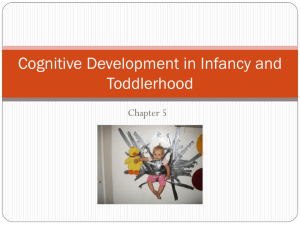Concurrent Session B
advertisement
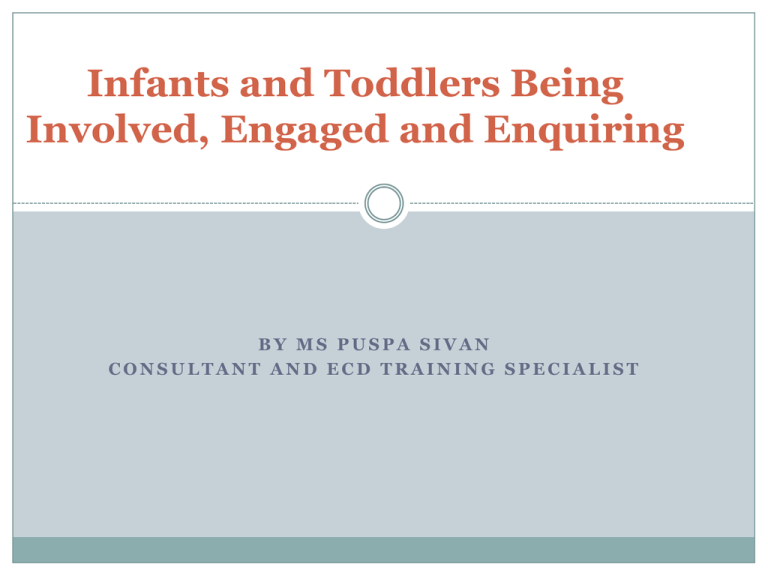
Infants and Toddlers Being Involved, Engaged and Enquiring BY MS PUSPA SIVAN CONSULTANT AND ECD TRAINING SPECIALIST Early Years Are Learning Years: The Process of Empowerment Begins in Infancy-Levitt Infants and toddlers are phenomenal learners, actively engaged in absorbing new information, imagining, experimenting and problem solving “Learning starts in infancy, long before formal education begins, and continues throughout life” -Magda Gerber Infants can’t help but learn all the time, so the question really isn’t “are they learning?”, but rather “what are they learning?” Developmental Needs of Infants and Toddlers “Child development is ‘a process of change in which a child learns to handle even more complex levels of moving, thinking, feeling and relating to others” - Myers Socio-emotional Deveopment Longitudinal studies confirm that the effects of early secure attachment in children are significant and long lasting. With the cutting of the umbilical cord, physical attachment to our mother ends and psychological attachment begins Attachment Theory Attachment is the cornerstone of infant development: • about relationships, how they are formed, what happens during the first intimate relationship with the nurturing adult, and what consequences are for later development. • close attachment relationship between responsive caregiver and dependent infant –seen as an adaptation needed for infant’s survival Socio-emotional Development “Primary caregivers create a sense of trust in a child not by the particular techniques they employ, but by the sensitiveness with which they respond to the child’s needs” - Weiser Socio-emotional Development For a young child’s brain to thrive, the child needs to be loved, held, talked to, read to and allowed to explore. Promote Relationship-Based Interactions and Experiences Relationship-based infant-toddler programmess provide warm, nurturing, responsive interactions and experiences between all parties in the infanttoddler setting Cognitive Development “Babies do not gain knowledge or insight by sitting back and contemplating what might happen. Instead, they look, taste, smell, hear, feel, and act…….Through sensing and acting, infants and toddlers build intelligence” - Schickedanz (1998) In active learning settings, children engage with an abundance and variety of materials that challenge their thinking skills and support their sensory, whole-body approach to learning Brain Research The brain constantly looks to link things together - by sight , smell, sound and space- to make sense of the world Sensory Experiences • Infants and toddlers are provided time and experiences each day to see, smell, hear, taste and touch a variety of stimuli. • The environment provided is rich in experiences and materials that infants and toddlers can explore with all their senses, thus promoting optimal development in all areas. IIntentionally Promote Language Development • Educarers talk, sing, read and communicate with infants and toddlers throughout the day. • Educarers respond in a positive manner to individual children's communication attempts. The educarer understands and adapts the language interactions to include cultural and linguistic differences. • Educarers talk with each child about things that relate to that child's everyday experiences. Cognitive development- acc. to Vygotsky Scaffolding Place the child in the context of language Bring child’s thinking/performance to a higher level Engage the mind of the child ‘Serve and Return Interaction’ A process called the “serve and return” interaction between young children and their parents and caregivers is key to healthy brain development (Shonkoff, 2009). ‘Serve and Return Interaction’ Serve and return occurs when young children solicit interaction through their babbling, gestures, facial expressions or focusing on an interesting object or event (the “serve”), and adults share and support the child’s experience or focus of attention (the “return”). The serve and return interaction helps to create neural connections that build later cognitive and emotional skills. Inborn dispositions: Innate curiosity is one disposition that parents and caregivers can readily see in typically developing babies’ need to explore and learn Children are born with the natural dispositions of curiosity to observe, seek, know, find out, search, investigate, try, problem solve, create, and to invent Infants and toddlers are process-oriented They think with their heads, hands and feet Social Dispositions Empathy Pro-social behavior Review Infant and Toddler Development Attachment Needs Exploratory Needs Curriculum for Infants and Toddlers Caregiving As Curriculum Play As Curriculum Diaper changes, feedings, baths, brushing teeth, dressing and undressing, nose wiping, finger and toenail clipping are all prime time for learning But this is only true if we pay attention while we are doing those things, tell our babies what’s happening and invite them to participate with us. We need to interact rather than distract. Responsive Routines Use routines as opportunities for emotional interaction and learning Hold babies during feeding to ensure safety and to meet their emotional needs. Talk softly, hum, sing or be quiet according to the infant's cues Sit with toddlers for eating rather than waiting on them Provide opportunities for toddlers to begin to serve themselves, pour water out of a small pitcher, and clean the table with a sponge. Playtimes Use playtime as opportunities to foster relationships and connections. Infants and toddlers love and need lap time. Sing songs and do finger plays. Sit on the floor with children, hide objects for child to find, roll a ball back and forth, build towers with soft toddler size blocks, model play with age appropriate toys. Allow children to experiment with toys and objects without correction If we engage with infants and toddlers during caregiving tasks, they learn about their bodies and how to care for them. They learn language naturally and internalize it because they don’t just hear our words, they experience them through all of their senses. (“Can you help me squeeze the warm water out of this yellow sponge?”) Most importantly, infants and toddlers learn that their participation is expected and highly valued. Trust infants and toddlers to be initiators, explorers and self-learners Creating Positive Learning Environments 1. Opportunities for Interaction Places to watch and play near adults and other children Places to connect and cuddle with adults Infants and Toddlers learn more when their toys are doing less Interestingly, they engage with passive, simple, open-ended toys and objects for much longer, too 2. Learning Environment The caregiver uses space, relationships, materials, and routines as resources for constructing an interesting, secure, and enjoyable environment that encourages play, exploration, and learning. A Good Caregiver Is ……. Loving, respectful and responsive respects the baby’s individuality offers good surroundings
